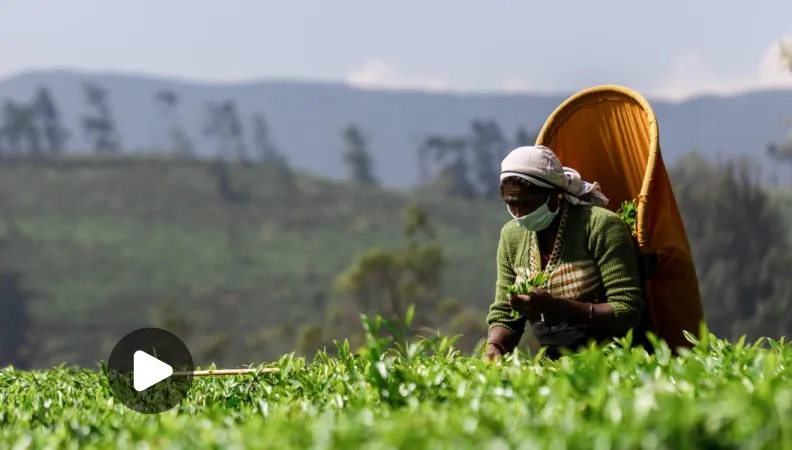Share the page
Sri Lanka’s Ceylon Tea: Combating Counterfeits and Protecting a Prized Industry
Published on

Next to water, tea is the most widely consumed drink on the planet. And although Sri Lanka is one of the world’s top producers of the beverage, counterfeit products threaten the country’s own Ceylon tea industry. In a project backed by AFD and the Sri Lanka Tea Board, tea producers are working to obtain a special certification to protect an industry employing more than 2.5 million people. On World Tea Day, we look at how a Geographical Indication could turn things around.
If you’ve ever had a hot cup of English Breakfast or Earl Grey, you’ve tried Ceylon Tea. Grown in the lush hills and mountains of Sri Lanka, Ceylon has grown for more than 150 years to become the country’s second largest export. Ranking among the top four tea producers worldwide, Sri Lanka is a major player in the market for the world’s most consumed beverage after water.
The threat of counterfeit teas
However, Ceylon tea is also susceptible to exploitation and misrepresentation in the international market. Inferior teas are often passed off as Ceylon, compromising brand value and undermining consumer trust, with potentially serious economic consequences.
“What we encounter in the global markets is that there is a lot of counterfeiting going on,” says Niraj De Mel, Chairman of the Sri Lanka Tea Board (SLTB). “Where they pack Ceylon tea with different teas, Sri Lanka stands to lose.”
An internationally recognized label could help distinguish the Ceylon original from fakes. Which is why AFD has signed a €1 million grant with SLTB and the French Agricultural Research Centre for International Development (CIRAD), for the development of a geographical indication (GI). The grant will provide technical assistance to establish the relevant certification systems, over four years.
Further reading: Supporting rural development and valuing countries' hidden treasures
A GI would attest to Ceylon tea’s authenticity, safeguard it against misappropriation and ensure adherence to stringent quality standards. This would in turn strengthen the tea’s global reputation and market competitiveness.
Shoring up the country’s crucial export could help in Sri Lanka’s effort to emerge from the economic crisis that led to social unrest and toppled the government in 2022.
Added Value of GI Certification for Ceylon Tea
“GI certainly helps us to get to where we want to go, because it would provide protection for Ceylon tea, especially if it can be packed in Sri Lanka, so that there is more employment creation in the country.”
The four-year process towards getting GI includes measures ranging from the protection of traditional agricultural and industrial knowledge and capacity building, to quality control and the promotion of the Ceylon Tea Geographical Indication.
Promoters will not have to reinvent the wheel. Several Ceylon teas – which include black, green and white teas – are already well known, particularly those that comprise the base of blends like Earl Grey and English Breakfast.
Further reading: Using Geographical Indications as a development tool
Most Ceylon tea leaves grow in Sri Lanka’s south-central area, across seven regions, from the mountains of Nuwara Eliya, where pale and fragrant teas produce Orange Pekoe, to the “low-grown” black tea of Ruhuna.
As with Champagne (whose grapes are grown and bottled in France’s Champagne region) or Scotch Whiskey from Scotland, GIs protect products unique to the places where they are grown or produced. Laws then prohibit similar products produced elsewhere from using the same names.
Boosting market access, improving employment
The ramifications of the GI certification extend far beyond the realm of product protection. As a key agricultural export, the tea industry contributes a great deal to employment generation, foreign exchange earnings, and rural development.
The tea industry provides employs more than 2.5 million people in Sri Lanka, including 500,000 small-scale farmers, who contribute to 75% of the nation's tea production.
“About 90% [of Ceylon tea] is grown by small farmers,” says Chaminda Jayawardana, Managing Director of Lumbini Tea Valley Ceylon Ltd. GI recognition in turn has the potential to influence pricing, which can then produce benefits to growers. “We expect this GI to come into our system and give us better value for small farmers.”
Further reading: Looking back on 15 years of AFD support for Geographical Indications
Better practices for better quality tea
The protection afforded by GI certification not only translates into enhanced market access and premium pricing for Ceylon tea, it also contributes to the sustainability of tea cultivation, as more money is plowed into increasingly sustainable practices.
“The objective of [securing] the GI label is that only good quality tea will be authorized to use the name Ceylon tea,” says Delphine Marie-Vivien, of CIRAD. “GI is a wonderful tool to build bridges up and down the value chains, from growers to exporters to consumers. This is very important for the Sri Lanka tea industry.”
The project, supported by AFD, is funded by a €1 million Fund for Technical Expertise and Experience Transfers (FEXTE) grant.
